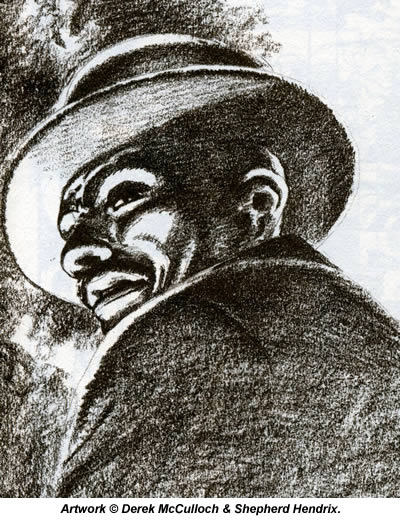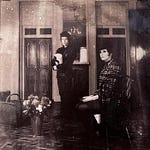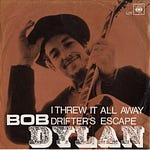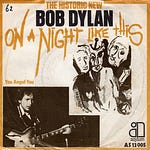Sign on the Window isn't the Bob Dylan podcast you need, but it's definitely the one that you want! Each week we select a Dylan song at random, live with the song for a week (or two) and then get together to discuss. This week 1993's rendition of the classic "Stack a Lee." (Episode cover art from Derek McCulloch and Shepherd Hendrix)
This is a huge episode: we talk Lee Shelton and Billy Lyons (5:00), break down the history of the song pre-war with emphasis on Mississippi John Hurt, Frank Hutchison, Ma Rainey (14:30) and post-war (25:30) with emphasis on Archibald, Lloyd Price, Taj Mahal, and Nick Cave and the Bad Seeds. We recommend (1:12:00) and we select a Valentine's Day episode (1:18:00).
Next week: She once was a true love of mine
CONTEXT (2:50)
"Stack a Lee" was recorded in May 1993 in Dylan's garage in Malibu. The song would be released on October 26, 1993 on World Gone Wrong. The album would go on to win a Grammy award for Best Traditional Folk Album, peaking at #70 in the US and #35 in the UK.
As for "Stack a Lee," it's complicated. Malcolm Laws identified “Stagolee” as his song group ‘I15,’ and #4183 in the the Roud Folksong Index, with over 70 citations. Dylan, in his liner notes (in better detail than just not having any in last year's Good As I Been to You ):
STACK-A-LEE is Frank Hutchinson’s version. what does the song say exactly? it says no man gains immortality thru public acclaim. truth is shadowy. in the pre-postindustrial age, victims of violence were allowed (in fact it was their duty) to be judges over their offenders-parents were punished for their children’s crimes (we’ve come a long way since then) the song says that a man’s hat is his crown. futurologists would insist it’s a matter of taste they say 'let’s sleep on it' but they’re already living in the sanitarium No Rights Without Duty is the name of the game and fame is a trick. playing for time is only horsing around. Stack’s in a cell, no wall phone. he’s not some egotistical degraded existentialist dionysian idiot. neither does he represent any alternative lifestyle scam (give me a thousand acres of tractable land & all the gang members that exist and you’ll see the Authentic alternative lifestyle, the Agrarian one) Billy didn’t have an insurance plan, didn’t get airsick yet his ghost is more real and genuine than all the dead souls on the boob tube – a monumental epic of blunder and misunderstanding, a romance tale without the cupidity.
LEE SHELTON & BILLY LYONS (12:30)
We spend the episode marveling at how the real-life events were bent to the will of song, but there was a murder on Wednesday — Christmas night — 1895. From the St. Louis Globe-Democrat:
William Lyons, 25, colored, a levee hand, living at 1410 Morgan Street, was shot in the abdomen yesterday evening at 10 o’clock in the saloon of Bill Curtis, at Eleventh and Morgan Streets, by Lee Sheldon, also colored.
Both parties, it seems, had been drinking and were feeling in exuberant spirits. Lyons and Sheldon were friends and were talking together. The discussion drifted to politics and an argument was started, the conclusion of which was that Lyons snatched Sheldon’s hat from his head. The latter indignantly demanded its return. Lyons refused, and Sheldon withdrew his revolver and shot Lyons in the abdomen.
Lyons was taken to the Dispensary, where his wounds were pronounced serious. He was removed to the City Hospital. At the time of the shooting the saloon was crowded with negroes. Sheldon is a carriage driver and lives at 911 North Twelfth Street. When his victim fell to the floor Sheldon took his hat from the hand of the wounded man and coolly walked away. He was subsequently arrested and locked up at the Chestnut Street Station. Sheldon is also known as ‘Stag’ Lee.
We dive deep into the song, the mythos, the legend. We listened to dozens of versions over half a century, looked at John Russell David's 1976 PhD thesis Tragedy in Ragtime: Black Folktales From St. Louis, talked stetson hats with the help of Cecil Brown's Stagolee Shot Billy, and even read James Baldwin's "Staggerlee Wonders" in Jimmy's Blues.
Patrick Blackman, in Sing Out! in 2013, wrote:
Stagolee is a bad-ass shaman made from the magic of a uniquely American people. He isn’t the first. Enslaved black folks borrowed Samson from the Bible and made him their own in the light of a Sunday morning. But on city streets near the Big River, their emancipated, hard-pressed children summoned Stagolee from their own blood, sweat, spit, and tears on a cold Saturday night. All they needed was a spark and some lead from Lee Shelton’s forty-four. And today, because of such supreme art applied to a simple murder, we can all see ourselves and find spirit in Stagolee if we want.
Everything about the Stagolee those prisoners created was a white man’s nightmare. He had the biggest gun. He killed a man over a Stetson hat. The law men were too scared go after him. When they caught him and finally tried to hang him, his neck wouldn’t break. And when he did die, he even took over Hell from the Devil!
Stagolee - A Digital Compendium: The Classics - Sing Out!
The Song and Myth of Stagger Lee
SONG ITSELF (12:00)
Cecil Brown, in Stagolee Shot Billy, wrote:
…the structure of Stagolee remains stable. Although each performance of Stagolee produces a different version even when several performers use the same motifs, the sequence of events and the kind of figure created through the narrative remain essentially the same.
Patrick Blackman in his Sing Out! essays identifies the different types of song, which I tried to color coordinate....
"Police officer, how can it be?"
Concerns the police, the chase and his fate — he's a bad man
"When you lose your money, learn to lose,"
Concerns gambling and vice, with good advice on not being a sore loser
"All about that John B. Stetson hat"
Concerns that hat, manhood, and (by extension) freedom
"And the leaves come tumbling down"
Concerns that facts: these tracks have similar bones but insert their own points of view
"Could be a rainy morning, could be a rainy night"
Concerns the legend and incorporates all the versions into one — being all and none at once
"As Stagger Lee lit a cigarette, she shot him in the balls…”
Concerns the Stagger Lee Extended Universe™ with new characters (Delia; Louis Collins)
“Don’t you know it is wrong to cheat the trying man?”
Concerns Stagger Lee as the protagonist in a white supremacist world gone wrong
SONG PRE-WAR (14:30)
In our pre-war section, we look at versions by unrecorded renditions to Mississippi John Hurt, Long Cleve Reed, Frank Hutchison, Cab Calloway, Woody Guthrie, and Ma Rainey.
1897: Leavenworth Herald, August 21, 1897
It is understood that Prof. Charlie Lee, the piano thumper, will play ‘Stack-a-Lee’ in variations at the K. C. Negro Press association. Scarcely any convention held in K. C. is complete unless Prof. Lee is down on the program.
1910: Miss Ella Fisher of Texas
Ella Fisher, in Texas, writes to John Lomax regarding "The Ballad of Stagalee:" "This song is sung by the Negroes on the levee while they are loading and unloading the river freighters." There's also a prison context, which we've talked about before — see “Outlaw Blues.” Per Cecil Brown, John and Alan Lomax were exploring:
a new musical genre and a repertoire that voiced the feelings and fantasies of the inmates and spoke tragically and ironically of the brutal conditions in the prisons. In every prison they visited, at least one work song was about Stagolee.
1925: Ma Rainey — "Stack O Lee Blues"
Features a young Louis Armstrong on cornet. Peter Blackman writes:
Though that first line is instantly recognizable, overall the lyrics are conflated with those from other songs – most notably 'Frankie and Johnny,' Stagolee’s other famous East St. Louis cousin – likely packaged into a powerful number to fit Rainey’s style.
1927: Long Cleeve Reed & Little Harvey Hull "Original Stack O’Lee Blues
There is only one known copy of "Original Stack O’Lee Blues" by Long Cleeve Reed & Little Harvey Hull in existence. The owner, Joe Bussard, was offered $30,000 and he laughed it off with no intention of ever selling. He wants to be buried with it.
Stag Lee was a bully, he bullied all his life. Well he bulled to Chicago town with a ten cent pocket knife.
1927: Duke Ellington / Cab Calloway — "Stack O'Lee Blues"
1927: Frank Hutchison — "Stackalee"
As noted above, Dylan cites Frank Hutchison's version as his inspiration. Hutchison was born in West Virginia in 1897. Dylan probably heard it in Harry Smith's 1952 anthology American Folk Music. As Michael Gray notes:
to hear this 1927 Hutchison side is to recognize just how closely Bob Dylan follows it, in lyrics, melody, guitar-part, harmonica and, most importantly, in spirit, almost 50 years later. When you hear the Hutchison, you come to appreciate what a resourceful, knowledgeable, live-wire thing the Dylan recording really is.
1928: Mississippi John Hurt — "Stack O'Lee"
Probably the definitive version.
1931: Woody Guthrie — "Stackolee (Stagger Lee)"
Woody's first verses about his life and work is new. From Staggerlee.com:
Black singers commonly sing variations on 'They was all glad to see him die.' White singers commonly sing variations on 'We was all glad to see him die.' There are continual subtle variations between black and white performances of this song.
SONG POST-WAR (25:30)
In our post-war section, we listen to: Archibald, Cisco, Lloyd Price, Dave Van Ronk (and Furry Lewis), Eisley Brothers, Ike & Tina Turner, Wilson Pickett, Taj Mahal, Dr. John, Grateful Dead, The Clash/Runners, Bob Dylan, Nick Cave & the Bad Seeds, Beck, Black Keys, Black Snake Moan, Modern Life is War, Josh Ritter ("Louis Collins" by John Hurt)
1950: Archibald (Leon T. Gross) — "Stack-A-Lee, Parts 1 & 2"
This was their first mainstream hit. This is the version that Lloyd Price will hear while serving in Korea. Part 1 is instrumental, ragtime jazz; Part 2 is the codifying of the myth up to the present tense:
waxed on two sides of a single but can be heard in its entirety on YouTube. The second side sees Stack down in Hell, and includes some other interesting elements. It reached #10 on the American ‘R and B’ chart in the year it was recorded, and proved to be a jewel in Archibald’s slim discography.
Derek McCulloch and Shepherd Hendrix, in 2006, on their blog, talk about this version being the basis for all the themes, motifs and tropes:
Part 1: the bulldog barks; Stack-A-Lee and Billy gamble; Billy cheats and wins Stack’s Stetson; Stack gets his .44; Bill pleads, citing his children and his sickly wife; Stack shoots Billy and the bullet breaks the bartender’s glass.
Part 2: Stack stumbles to his mother’s door, shot in the left side by the police; his funeral is attended by women dressed in orange and red; Stack meets the devil and enquires after Billy’s whereabouts; the devil hears a rumbling underground and surmises that Stack is abusing Billy; the devil sits down on his devil shelf and observes that anyone who wants Stack is welcome to go get him themselves.
1954: Cisco Houston — "Stagolee (Stagger Lee)"
1958: Lloyd Price — "Stagger Lee"
The big one. "Stagger Lee" was the more popular B-side to "You Need Love." It was a surprise #1 record, selling 200,000 in a day at its peak. It was also the first #1 hit to be censored (Dick Clark found it too violent for his American Bandstand audience).
James P. Hauser, at the Stagger Lee Files speaks to a deeper meaning for black Americans hearing the song:
Price conjures up a clear night with a yellow moon and leaves tumbling down from the trees. You could call it an incantation. Then a ll hell breaks loose as seven quick horn blasts (da-da da-da da-da da) shatter the calm. This introduction evokes another song — a slave spiritual titled 'Joshua Fit the Battle of Jericho' — in several ways. For example, the line that completes the intro to Price's record 'and the leaves came tumbling down' echoes the spiritual's line 'and the walls came tumbling down.'
1962: Dave Van Ronk — "Stackerlee"
An interpretation of "Billy Lyons and Stack O' Lee" from Furry Lewis (recorded in 1927 and reissued in 1947 by Alan Lomax).
1963: The Isley Brothers — "Stagger Lee"
You're hearing a young Jimi Hendrix on guitar. They created a scandal while perfomring it on UK TV when Ron pulls a gun from his coat and mimes the shooting.
1965: Ike and Tina Turner — "Stagger Lee"
A rewrite of the story as a brawl in a modern-day Go-Go bar.
1968: Wilson Pickett — "Stagger Lee"
1969. Taj Mahal — "Stagger Lee"
Recorded multiple times by Taj Mahal. Originally on 1969s Giant Step but we listened a version from the 21st century and it was excellent. Cecil Brown writes about Taj Mahal:
Backstage, sitting in a folding chair, Taj told me how he came across the legend. “The first I heard of Stagolee was from Lloyd Price,” he said. “I was a Lloyd Price fan. I was always dancing to him. Then by the 1960s, I kept hearing it on blues anthologies – Mississippi John Hurt, and Furry Lewis’s versions. As a child, I’d heard these stories about the bad man – bad man Stagolee – from my mother, who was from the low country in South Carolina. Then there was the other side of my family, my father is from the Caribbean, and from him I heard about ‘bad John’. They would say, ‘Bad John, stay out he way, man!’
Taj laughed. This was great fun for him. He was Stagolee. As long as there are living historians like him, Stagolee will never die.
1972: Dr. John — "Stack-A-Lee"
A cover of the Archibald version with a new ending
Now I told you all my little story And sang you all my little song But Stack-a-Lee and Billy Lyons They both dead and gone
1978: The Grateful Dead — "Stagger Lee"
A rewrite with a modern perspective (and recorded for their Shakedown Street album). Members of the band still perform it live.
According to the Dead’s website, their main lyricist Robert Hunter 'wrote a version that he performed solo, and Jerry Garcia subsequently re-ordered the lyrics and rewrote the music for the Grateful Dead’s version,' released in 1978.
After the first verse, we begin to move beyond the traditional narrative and into Hunter’s revision – Delia DeLyon, Billy’s widow, brings Stagger Lee to justice when the sheriff won’t do the job. Elements of the traditional lyrics never wholly disappear, but the big picture is a new one.
1979: The Clash — "Wrong 'Em Boyo"
The Rulers recorded a ska version and significantly rewrote the story of Stagger Lee as "Wrong Embryo." It’s still Stagger Lee and Billy, butt Stagger Lee is the hero and Billy is the villain. The Clash cover it for London Calling in 1979.
The Clash introduced a new generation and a new sort of listener to this old tale, and by their reckoning Stagger Lee isn’t really a bad man anymore – Billy was a liar and a cheat and he got what was coming to him.
Accoridng to Patrick Blackman in Sing Out!, Price’s version was the jumping off point for this highly original take on the tale.
While it may no longer fit neatly into a standard framework for understanding 'Stagger Lee,' the fact that a rewrite wherein the American 'bad man' is transformed to a Jamaican 'rude boy' and then without much effort at all is transformed into a symbol meaningful to a disaffected British 'punk' speaks volumes about the power and flexibility of the narrative, the music, and what the common people across the Anglophone world might share regardless of their race.
1993: Bob Dylan — "Stack a Lee"
1996: Nick Cave & the Bad Seeds — "Stagger Lee"
This, uh, creative, rewrite is on his 1996 album Murder Ballads. The song has been a mainstay of their live set ever since. From StaggerLee.com:
The gods gave us this song and they were pissing themselves with laughter when they did it.
Apparently, Nick found the lyrics in a collection of folk poetry gathered in New York prisons in the 50s and 60s. We talk Ronald B. Newman and Murray B. Binderman's The Life — The Lore and Folk Poetry of the Black Hustler (University of Pennsylvania Press, 1976) when examining "toasts" — "a form of poetry recited by certain blacks – really a performance medium, widely known within a small… community and virtually unheard of outside it. They are like jokes: no one knows who creates them, and everyone has his own versions" — and the larger-than-life aspects of Stagger Lee over the years:
Cecil Brown, in Stagolee Shot Billy, described how he first learned the story of Stagolee from his Uncle Lindsey in the late ’50’s or early ’60’s from a toast in rural North Carolina, and he is clear what the Stagolee of that story meant
In those days, to young black field hands sitting in the shade of a tree at the end of the tobacco road, Stagolee was as impulsive, as vulgar, as daring, and as adventurous as they wanted him (and themselves) to be.
According Patrick Blackman at Sing Out!:
But in many toasts, such as the one linked directly above, the speaker is describing himself – the narrator is Stagolee. This is not the case in the vast majority of variants in the ballad tradition. Cave may be speaking in the third person, but as the narrator he certainly delivers in a way that lets the listener know he wishes he was Stagolee.
2001: Beck — "Stagger Lee" and "Devil's Haircut"
Beck released a faithful version of Mississippi John Hurt's "Stagolee" recorded at Sun Studios in 1994, but his 1996 hit "Devil’s Haircut" was a rewrite of the Stagger Lee myth.
I imagined Stagger Lee… I thought, what if this guy showed up now in 1996. The song had this Sixties grooviness, and I thought of using him as a Rumplestiltskin figure, this Lazarus figure to comment on where we've ended up as people.
2004: The Black Keys — "Stack Shot Billy"
Guitarist Dan Auerbach said:
I had Mississippi John Hurt's version and a bunch of other people's versions, and I thought, 'These guys all wrote their own versions of this song; why couldn't I do my own version?
The facts have changed now, as “Stack shot Billy in the back of the head.”
2006: Samuel L. Jackson performs "Stagger Lee" for Black Snake Moan
2007: Modern Life is War — "Stagger Lee"
Released on 2007's Midnight in America. The hardcore band's Stagger Lee walks into "J.D.'s" — a bar in Marshalltown, Iowa. He learns that his girl is with Bill DeLyons at the Flamingo — a seedy motel in Marshalltown. He's got a .45 instead of the .44, but the night ends the way you'd expect.
2010: Josh Ritter — "Folk Bloodbath"
"Folk Bloodbath," on Ritter's album, So Runs the World Away, is a great meta example of pulling from so many sources to craft something exciting but also contextually rewarding. In Ritter's version, Stagger Lee killed a man named Louis Collins (a folk song in its own right... another murder ballad for another day), and 'Hangin' Billy Lyons is the judge who sentences Stagger to hang. Lyons, finally getting to pass judgment, says to Stagger:
you've always been a bad one, you're gonna hang this time
Ritter would say:
Stackalee is in so many songs, and he’s always the bad guy. I thought it’d be fun to give him some justice and have Billy Lyons—the character he kills in hundreds of old folk songs—be the judge who sentences him. The characters in those songs are so living and they have so much to give. From song to song, the characters end up with the same fate—but they get there in different ways depending on the version. For “Folk Bloodbath,” I just wanted to crash them all together.
It's ends with the gorgeous:
And I’m looking over rooftops, and I’m hoping that it ain’t true
That the same God looks out for them, looks out for me and you
The angels laid them away…
DOES IT WORK IN 2019?
It's worked thus far....
I'll let Blackman close us out:
Historically, its utility as a means of redefining black manhood in a world of white privilege and racial hostility is well-established. But the ballad’s racial context is not always relevant in 21st century performances. Of course, that doesn’t mean these new versions can’t evoke psychological responses that are as powerful – they surely do. And it doesn’t mean that they take away from the Stagolee of black history – they surely don’t.
THE EPISODE’S PLAYLIST
RECOMMENDATIONS (1:12:00)
Kelly listened to Dumb Gay Politics as well as our Buffy podcast If the Apocalypse Comes, Beep Me, and maybe The Orville.
Daniel watched PUP's new video for "Kids" and Beirut's latest, Gallipoli
ENDINGS
Remove #37 "Stack A Lee" off our list. There are 434 songs left. Daniel gave Kelly 5 Valenine's Day choices:
"Girl From the North Country" (#175 on our spreadsheet)
"She Belongs to Me" (#195)
"Abandoned Love" (#248)
"Make You Feel My Love" (#12)
"True Love Tends to Forget" (#169)
Kelly chose the excellent "Girl From the North Country," off 1963's Freewheelin' Bob Dylan (and I guess 1969's Nashville Skyline).
Follow us wherever you listen to podcasts. See our real-time playlist See That My Playlist is Kept Clean on Spotify. Follow us intermittently on Twitter and Instagram.
Tell your friends about the show, rate and review wherever they let you, and consider supporting us by subscribing or at Patreon.











